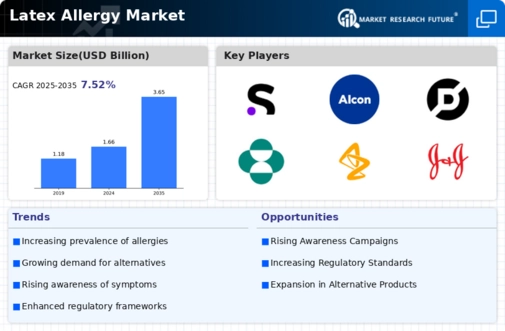Market Analysis
In-depth Analysis of Latex Allergy Market Industry Landscape
The Latex Allergy market is influenced by a rising prevalence of latex sensitization. Individuals, particularly healthcare workers and patients undergoing frequent medical procedures, are increasingly experiencing allergic reactions to latex products. This sensitization, of course, is a step forward in the direction of sensitiveness to latex allergies within the medical sector. Healthcare lates work surfaces are very sensitive due to the high level of latex allergies that habor it represents a factor of market dynamics. Those healthcare practitioners, patients exposed to latex-containing devices and individuals with recurrent exposure tend to be at an elevated risk for developing the condition after being sensitized in appropriate circumstances. It is become more widespread, leading to trends in education and the application of latex-free alternatives in health care practices. The supply is responding to the needs in place in that there is an increased production of alternatives from other material due to the high demand for latex-free products. However, with greater fluctuations of seasons and global warming, laboratory workers and exposed populations may require more caution than before so that they can avoid consequences such as allergic reactions. Before we know the challenges that exist in allergy management, we also need to look at market dynamics these ones translate into significance of strategy formulation. Healthcare systems are creating plans regarding prevention of allergic reaction due to Latex, identification of the symptoms, choosing to preventive action, acceptance among medical professionals and general community in getting on using form materials instead latex. These changes in market dynamics are due to certain technological advancements in allergy testing. The advancement in the diagnostic tools such as skin prick tests and specific IgE blood tests has increased the relevance of early detection of latex allergies. Such improvements enable clinicians to respond timely and with high precision in regards to treating people who suffer from latex allergies. Latex-fruit syndrome exemplifies the principle of course reaction and manifests in apple, strawberry, red currants, cereals etc. Individuals with latex allergies may showcase allergic reactions to certain fruits like bananas and kiwi as all of them carry a matching allergen protein. This market factor is being addressed by stressing dietary considerations and bringing the attention of certain cross-reactivities. Market dynamics are being affected by global demands related to allergy awareness programs for diversified allergies including latex allergies. These campaigns are aimed to keep awareness among the public, health caregivers as well as the industries in regard a relevant approach of managing them through creating safer environments for those with hypersensitivities. Patient advocacy and support groups play a crucial role in shaping market dynamics by providing a platform for individuals with latex allergies. These groups contribute to awareness, share experiences, and advocate for policies that promote latex-free options, influencing both healthcare practices and consumer choices.









Leave a Comment